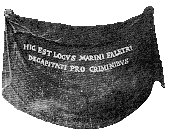THE
INSTITUTIONS
Thoughout Europe the Serenissima's
government was considered a model of stability, honesty
and demonstrated the possibility of combining the
monarchy, aristocracy and democracy, in the figures of
the Doge, the Senate and the Grand Council.
The Doge represented the unity of the Republic. He was
elected for life by the Grand Council, chosen from among
the greatest Venetian families and in general was older
than 70. The Doge's powers were very limited. He could
not make any decisions in the absence of the six
Councillors of the six sestieri of the city of Venice. He could not leave
Venice unless he was accompanied by at least two
Councillors. The actions of the Doge were controlled by
the Seignory, which consisted of the six Councillors, the
three heads of the supreme tribunal and the Doge himself.
Moreover the Doge had to pay for all official festivities
organized in the Doge's Palace, for any
restoration work done in the Palace and often had to pay
for military operations, without getting money from the
State. In fact it was not for a desire for money or power
that made Venetians desire to be Doge, but for the honor
of covering the highest position of the Republic and all
the noble families wished for the the privilege of having
a Doge in their family as this insured that their name
would be remembered through out history. Also some
commoners made extraordinary services to the State or
payed substantial sums to the government or to
impoverished nobles to buy titles of nobiltry and to have
their name written in the Golden Book so that they could
be members of the Grand Council and in this way hope for
a nomination as Doge. There is one dark spot in the
history of the Doges of the Serenissima. After the
election of Doge Marin Falier, he tried to lead a popular
conspirancy and was executed by order of the Council of
Ten. The Council of Ten in fact were responsible for
decisions about crimes against the State and about
decisions requiring absolute secrecy. They also prevented
the ambitions of influential citizens from threatening
the Venetian Republic.
of the city of Venice. He could not leave
Venice unless he was accompanied by at least two
Councillors. The actions of the Doge were controlled by
the Seignory, which consisted of the six Councillors, the
three heads of the supreme tribunal and the Doge himself.
Moreover the Doge had to pay for all official festivities
organized in the Doge's Palace, for any
restoration work done in the Palace and often had to pay
for military operations, without getting money from the
State. In fact it was not for a desire for money or power
that made Venetians desire to be Doge, but for the honor
of covering the highest position of the Republic and all
the noble families wished for the the privilege of having
a Doge in their family as this insured that their name
would be remembered through out history. Also some
commoners made extraordinary services to the State or
payed substantial sums to the government or to
impoverished nobles to buy titles of nobiltry and to have
their name written in the Golden Book so that they could
be members of the Grand Council and in this way hope for
a nomination as Doge. There is one dark spot in the
history of the Doges of the Serenissima. After the
election of Doge Marin Falier, he tried to lead a popular
conspirancy and was executed by order of the Council of
Ten. The Council of Ten in fact were responsible for
decisions about crimes against the State and about
decisions requiring absolute secrecy. They also prevented
the ambitions of influential citizens from threatening
the Venetian Republic.  In the Ballot Chamber of the
Doge's Palace,
where the portraits of the Doges are exhibited, the
portrait of Marin Falier is replaced by a black veil in
remembrance of his crime.
In the Ballot Chamber of the
Doge's Palace,
where the portraits of the Doges are exhibited, the
portrait of Marin Falier is replaced by a black veil in
remembrance of his crime.
In Venice no single institution monopolized power becouse
no single decision making body could operate unchecked by
another and the quick rotation of all offices made it
difficult for a single individual or faction to
appropriate power or to be corrupted becouse their time
in office is not long enough to be useful for such a pourpose.
Frauds in casting ballots have been known to happen in Venice, before ballots were cast, Grand Council members
milled about in front of the palace, on the
"broglio", where the most powerful tried to buy
the votes of impoverished nobles, called the barnabotti.
It is from this practice that the the word broglio
(entanglement) came in to use and is still used today.
 In the Ballot Chamber of the
Doge's Palace,
where the portraits of the Doges are exhibited, the
portrait of Marin Falier is replaced by a black veil in
remembrance of his crime.
In the Ballot Chamber of the
Doge's Palace,
where the portraits of the Doges are exhibited, the
portrait of Marin Falier is replaced by a black veil in
remembrance of his crime.